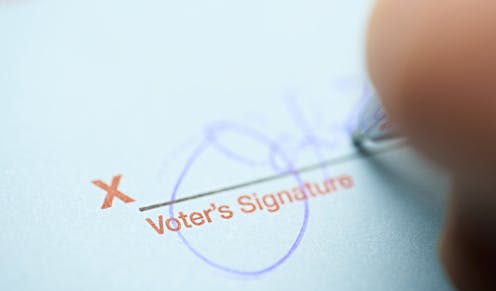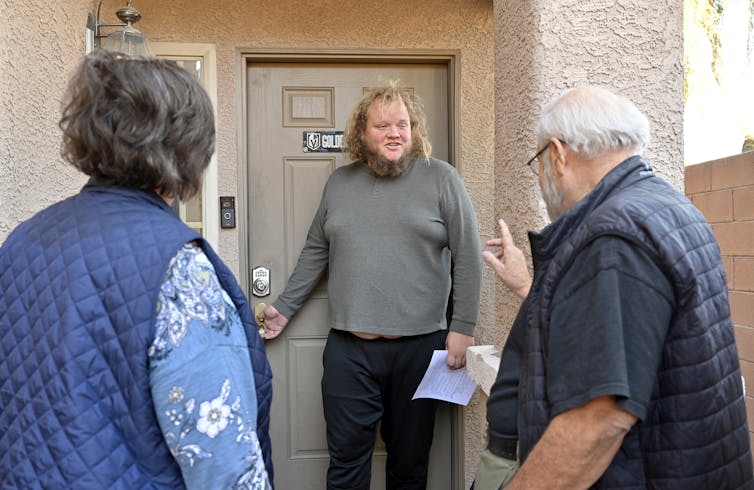What is ‘ballot curing’? Election expert explains the method for fixing errors made when voters cast
Ballot curing aims to ensure that every valid vote is counted, even those with messy signatures, misspelled names or missing IDs.

Most Americans used to vote on Election Day, and a small percentage of voters cast their ballots as absentee voters through the mail. That changed starting in the late 1970s, when some states began to allow no-excuse absentee voting and early in-person voting. Many more states chose to add these methods after the 2000 election, and by 2022, 60% of votes were cast in person at a polling place on Election Day, 21% were cast by mail and 19% were cast early in-person.
In the 2020 election, many states accelerated the shift already underway to voting by mail to keep people safe from contracting COVID-19. Mail ballots were the dominant method of return that year: 43% of ballots were voted by mail, 31% on Election Day and 26% early in-person. Voting by mail remains the second-most common method of returning ballots and will continue to grow – though it may never reach the level of 2020.
This rise in usage has created an issue that wasn’t seen much before: The need to “fix” a ballot where, due to a variety of reasons, the identity of the voter who cast the ballot can’t be verified. This process is called ballot “curing,” and it’s how states ensure that every valid vote is counted.
The Conversation’s politics and democracy editor, Naomi Schalit, spoke about ballot curing with Reed College political scientist Paul Gronke, founder and director of the Elections & Voting Information Center, who studies early voting, election administration, public opinion and elections.
What is ballot curing?
Ballot curing is a process that is allowed in some states that, if a ballot has been rejected or challenged because the signature didn’t match or a copy of an ID needed to be included, then the voter has an opportunity to come in within a limited period of time and cure that problem. They can, for example, come in and provide an updated or corrected signature – the most common problem – or provide the required identification.

Can that process happen after Election Day?
The process is triggered when an election office receives a ballot and identifies a problem that falls within the scope of the law and can be cured. As with seemingly everything in American elections, the deadlines and the window vary by state. Some states provide a quite lengthy period after the election. In Oregon, for example, the law provides a window of up to the 21st day after the election. In other states, it’s pretty narrow. In Michigan, it’s the third day after the election. In many but not all states, it’s tied to the deadline for certification of the vote.
So the idea is that everybody should have the opportunity to have their vote count.
I would agree with that. The idea is that we want to give everyone an opportunity to be represented. No one should be disenfranchised because of something relatively innocuous, like their signature doesn’t match, or when their ballot was being transported, it was humid or it rained, or something happened that meant the signature can’t be verified, or they forgot to include a copy of necessary identification. These are certainly not reasons why you would want someone to be disenfranchised.
The Nevada Secretary of State said told a CNN reporter on Nov. 5, 2024, that the state is seeing a surge in ballots with signature problems, many from young voters. As The Wall Street Journal reported, 12,939 ballots have been cured successfully, and 13,906 ballots remain to be cured. “This is an opportunity, probably their first time they’ve had to really use an official signature,” Secretary of State Cisco Aguilar told CNN, “and what’s on their driver’s license, what’s on their voter registration form and what’s on their ballot is a little bit different.” What’s going on here?
Young people these days – really, anyone under 40 – did not learn cursive when they were in grammar school. Why is that relevant in an election? Because there are clear patterns that people of a certain generation didn’t sign checks and were not sort-of trained in what election officials describe as writing their “formal signatures.” We also know that as people age, or suffer certain kinds of injuries, their signatures can change. And sometimes, people are just in a rush and don’t sign carefully.
Are there problems with how election officials in different states handle ballots that need to be cured?
In 2020, there were these major changes to our election system in order to adapt to provide a safe and secure voting environment during the pandemic. Many states ramped up vote-by-mail for the first time. What we saw in 2020 was that there were laws and procedures that fell out of sync with how people were voting. In some states, they mailed ballots to all eligible voters, yet they had laws that said you can’t begin the process of counting absentee ballots until the day of the election. That led to some slow counts in 2020 and opened up a window for charges of malfeasance, even though all that was happening was that officials were working through these piles of mail ballots.
Since then, many states have improved their laws and brought them in sync with voter behavior. For example, many more now allow election officials to begin the process of processing mail ballots – checking signatures, opening envelopes, preparing to scan – before Election Day. That should improve the speed of ballot counting in 2024.

But there are still some places that could improve. I will highlight Michigan as an example of a place where I’m a little bit concerned, and I’ve heard this also from Michigan officials. Michigan law says the county clerk shall notify the voter of the ballot deficiency by “telephone, email, or text message, if available.” If neither a phone nor email is available, the clerk uses U.S. mail. The voter may cure the ballot by filling out a cure form and returning it in person, electronically or by mail, but the cured ballot has to arrive back at the clerk’s office by 5 p.m. on the Friday following the election – that’s only three days. That’s really not much time!
Imagine a number of new voters casting ballots by mail in Ann Arbor, in Washtenaw County, and they vote by mail but turn it in at the last minute. And if there’s a problem with their ballot, then election officials have to generate some communications to them, and maybe they don’t have their cellphone, or the voter isn’t immediately responsive to email, and the whole process has to be completed in three days.
I have spoken to some local officials in Michigan who think that needs to be changed because the rate of voting by mail in Michigan is so high now – nearly one-third of registered voters requested an absentee ballot as of 21 days before the election, and there will be more absentee ballots requested and returned by Nov. 5.
It’s not just Michigan. There are a number of states that have comparatively high levels of voting by mail and fairly short curing periods. I don’t know the optimal time period, but anything less than five days is asking too much of clerks and of voters, and could disenfranchise people for making an innocuous mistake.
The way America votes in 2024 is not the way the country voted in 2000 or even the way we voted in 2016. We are in a world where one-third or more of ballots are vote-at-home ballots, and those numbers will continue to increase. Best practices include providing ample time to allow clerks to notify voters of any problems with their ballots, and voters to provide the necessary information to make sure their ballots are counted. If we can do it that way in Oregon, where I live – and Colorado, and Washington, and many other states – I’m sure other states can do it as well.
Paul Gronke receives funding from Elections Trust Initiative and Democracy Fund. He is a member of the Advisory Board of the MIT Election Data and Science Lab (MEDSL) and a member of the Circle of Advisors of the National Vote At Home Institute.
Read These Next
What’s at stake in Trump’s executive order aiming to curb state-level AI regulation
In the absence of comprehensive federal AI regulation, states have stepped in. The Trump administration,…
Sleep problems and depression can be a vicious cycle, especially during pregnancy − here’s why it’s
Inadequate sleep can have negative downstream effects on everyday cognitive functioning and mental health,…
Whether Netflix or Paramount buys Warner Bros., entertainment oligopolies are back – bigger and mor
Hollywood has seen this movie before.





